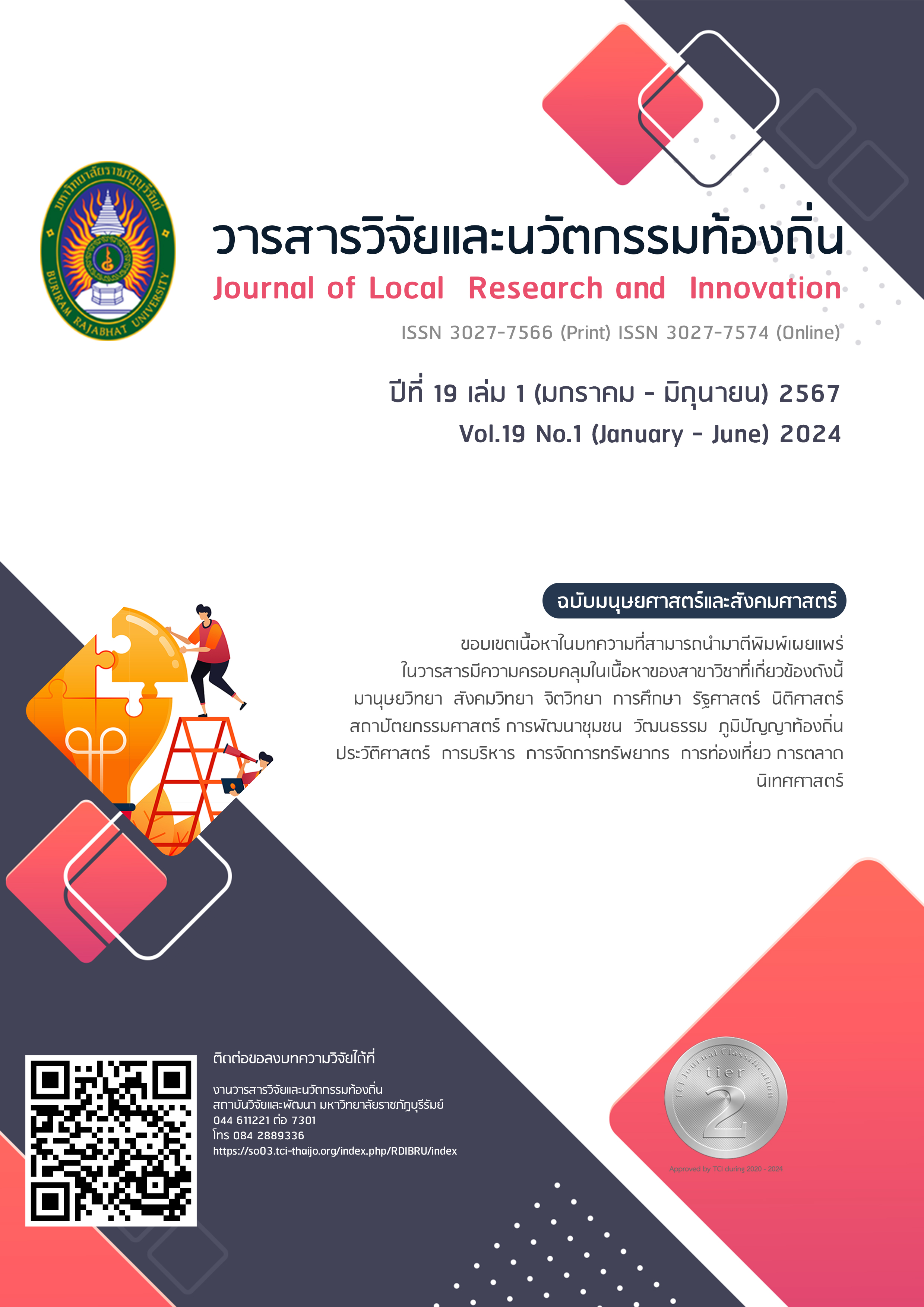เรือมอัปสรา : อัตลักษณ์นาฏกรรม การสร้างพลังอำนาจละมุน เพื่อส่งเสริมภาพลักษณ์และการท่องเที่ยวจังหวัดบุรีรัมย์
Main Article Content
Abstract
Research on Rueam Apsara : Dramatic Identity Soft power Creation For Image and Tourism Buriram Province The objectives are 1) to study the identity of the dancers in the performance of Ruem Apsara Buriram 2) to study the creation of soft power from the performance of Ruem Apsara Buriram to creation for image and tourism of Buriram Province. This research is qualitative research. By studying information from research documents and field data. from a population of 30 people using a purposive selection method that is accepted The sample group was a group of 5 knowledgeable people, a group of 4 practitioners, and a group of 20 general people using in-depth interviews. The tools used were surveys and structured interviews. Unstructured and observational interviews.
The research results found that Dramatic identity Ruam Apsara Buriram Boat It was built from ancient beliefs. Beliefs about the gods in the sacred area of Phanom Rung Castle A great ancient site that is evidence of the prosperity of the great ancient Khmer civilization. and good traditions that are linked with valuable dance, cultural heritage that has been with Buriram province for a long time and has become a Image of the province that can form a soft power that penetrates Into people's daily lives By the influence that arises from the identity of "dance" in terms of aesthetics, dance moves, songs, and costumes. Able to connect sacred areas that can stimulate the tourism economy and create an image of the province for the general public to recognize and accept the identity of Buriram Province
Article Details

This work is licensed under a Creative Commons Attribution-NonCommercial-NoDerivatives 4.0 International License.
เนื่อหาและข้อมูลในบทความ เป็นความรับผิดชอบของผุ้แต่ง
บทความในวารสารเป็นลิขสิทธิ์ของวารสารวิจัยและพัฒนา มหาวิทยาลัยราชภัฏบุรีรัมย์
References
กฤตพร แซ่อึ๊ง. (2562). นโยบาย Soft power กับการส่งออกวัฒนธรรมของเกาหลีใต้ ค.ศ.1997 - ปัจจุบัน. วิทยานิพนธ์ปริญญามหาบัณฑิต, มหาวิทยาลัยศิลปากร.
ชนะพล ผินสู่. (2564). ประเพณีขึ้นเขาพนมรุ้ง : พื้นที่พิธีกรรมและการสะท้อนอัตลักษณ์จังหวัดบุรีรัมย์. วิทยานิพนธ์ปริญญามหาบัณฑิต, มหาวิทยาลัยมหาสารคาม.
ธนวรรธน์ นิธิปภานันท์. (2556). ประเพณีประดิษฐ์กับการเปลี่ยนแปลงที่หัวหิน. วารสารคณะ มนุษยศาสตร์ และ สังคมศาสตร์ มหาวิทยาลัยขอนแก่น, 32(3), 148.
พัชราภรณ์ เกษะประกร. (2550). การประชาสัมพันธ์เพื่อสร้างภาพลักษณ์. กรุงเทพฯ : สํานักพิมพ์
มหาวิทยาลัยกรุงเทพ.
พิพัฒน์ ยอดพฤติการณ์. (2564). เศรษฐกิจสร้างสรรค์, สืบค้นเมื่อ 15 พฤษภาคม 2566. จาก https://www.prachachat.net/sd-plus/sdplus-sustainability/news-604476
ไมเคิล ฟรีแมน. (2546). สัญลักษณ์เขมร. กรุงเทพ : สำนักพิมพ์ริเวอร์ บุ๊กค์ 2546.
รุ่งรัตน์ ชัยสําเร็จ. (2549). กลยุทธ์การสร้างภาพลักษณ์เพื่อส่งเสริมการตลาดของธุรกิจ. สืบค้น 20
กรกฎาคม 2566. จาก https://www.utcc.ac.th/amsar/about/document13.html
วิมลรักษ์ ศานติธรรม. (2565). Soft power พลังแห่งการสร้างสรรค์. วิจัยปริทัศน์ ฉบับที่ 27. สำนักงานเลขาธิการ สภาผู้แทนราษฎร.
ศุภชัย สิงห์ยะบุศย์. (2553). หลวงพระบางเมืองมรดกโลก : พื้นที่พิธีกรรมและการต่อรองเชิงอัตลักษณ์ในกระแส โลกาภิวัตน์. มหาวิทยาลัยมหาสารคาม.
ศิราพร ณ ถลาง (2558). มองคติชน เห็นตัวตนชาติพันธุ์. กรุงเทพ : ศูนย์มานุษยวิทยาสิรินธร.
สุดาวรรณ หวังศุภกิจโกศล. (2567). บทบาทที่จะส่งเสริมการพัฒนาซอฟต์พาวเวอร์. สืบค้น 20 กรกฎาคม 2566. จาก https://www.thairath.co.th/money/economics/analysis/2756829
อิศราพร วิจิตร์. (2559). การสื่อสารอัตลักษณ์ความเป็นบุรีรัมย์เพื่อส่งเสริมการท่องเที่ยว. วิทยานิพนธ์วารสาร ศาสตรมหาบัณฑิต สาขาวิชาสื่อสารมวลชน มหาวิทยาลัยธรรมศาสตร์.

